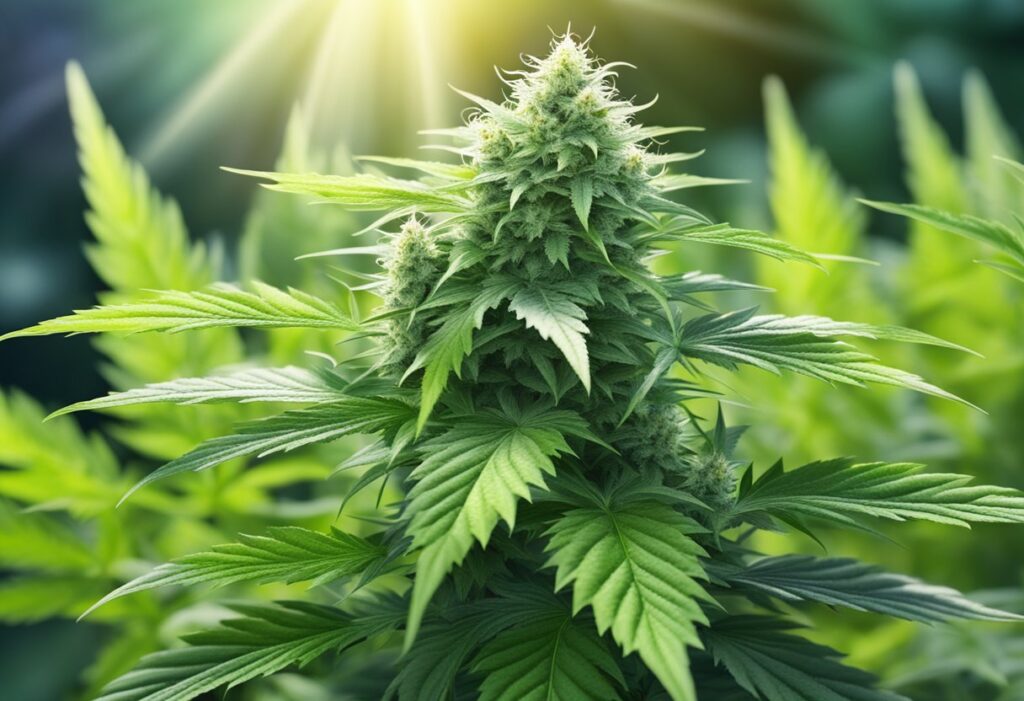
Your journey into the world of medical cannabis is incomplete without a look at one of the most well-known strains, White Widow. This legendary hybrid combines both sativa and indica benefits, making it a staple on dispensary shelves worldwide.
White Widow is a balanced hybrid stemming from a Brazilian Sativa landrace and a resin-heavy South Indian Indica. Its genetic makeup is a beacon of excellence in the world of cannabis strains, showcasing a robust heritage. Not only has White Widow enchanted users since the early 1990s, but it has also sired other notable hybrids like White Russian, Blue Widow, and Black Widow. Across the board, this hybrid strain is praised for its contribution to the lineage and development of new phenotypes, resonating with both growers and users alike.
When recognizing White Widow, your eyes first meet with the distinctive white trichomes that coat the buds, giving them an almost snowy appearance. These trichomes contribute to the strain’s high potency, with typical THC levels ranging from 20-25%. As a sativa-dominant hybrid, White Widow offers you both uplifting and relaxing effects, tailored for an array of medical conditions. Historically, it has claimed various awards, solidifying its place in the cannabis hall of fame.
Its aroma pulls you in with a potent, stinging scent reminiscent of ammonia, mixed with undercurrents of earthy pine. When it comes to growth, expect White Widow to flower in about 8 to 9 weeks, yielding an impressive crop that meets the needs of intermediate-level cultivators. It’s a staple strain for its resilience and the bountiful yield it provides when treated to optimal growing conditions.

When cultivating White Widow, a strain celebrated for its robust resin production and rich tapestry of flavors, you must consider the environment and techniques you use to optimize its yield and potency.
When growing White Widow, your decision to cultivate indoors versus outdoors can drastically affect the final product. Indoors, you have the advantage of controlling environmental factors; the strain typically flowers within 7-9 weeks and is ready for harvest by the end of October if grown outside.
Maximizing the yield and potency of your White Widow plants involves strategic cultivation practices.
By adhering to these cultivation methods, you can encourage robust growth and potent harvests from your White Widow plants. Remember, success comes with experience, but even if you’re a novice, this resilient strain offers a forgiving learning curve.
White Widow, a balanced hybrid strain of medical cannabis, is renowned for its therapeutic potency, uniting the muscle-relaxing properties of Cannabis Indica and the stimulating effects of Cannabis Sativa. Dive into its medical applications and hear firsthand from those it has helped.
With a complex profile of terpenes including pinene, limonene, and caryophyllene, White Widow is not only notable for its distinct pine and earthy taste but also for its wide range of therapeutic effects. Pain relief is one of the most commonly sought-after benefits, with users reporting alleviation from conditions such as chronic pain and migraines.
Dosage & Consumption: Patients report using various forms of White Widow, including buds for smoking, oil, and even edibles, with dosage varying broadly based on individual tolerance levels and the symptoms being treated. Higher THC levels offer strong symptom relief, but starting low and going slow is key to finding the right balance.
When you use the White Widow strain for medical purposes, anticipate pain-relieving effects due to its analgesic properties. It’s also known for offering a balance of relaxation and energy, which may help with stress and fatigue.
The White Widow strain is a hybrid, with its composition being about 50% indica and 50% sativa, delivering a blend of effects attributed to both types.
The flowering stage for White Widow plants typically lasts about 8 to 9 weeks, making it a fairly quick-to-harvest option for growers.
White Widow strain contains a THC content that can range from 18% to 25%, which is considered strong. Its high potency makes it a popular choice for experienced cannabis users.
White Widow is a staple in the cannabis community with disputed origins but is often credited to breeders in the Netherlands in the 1990s. It is believed to result from crossbreeding a South American sativa with an Indica from South India.
We ship and deliver world wide via USPS and various couriers.
We offer a wide range of secure and anonymous online payment options.
We care about you, our customer. Please contact us with any questions or concerns.
Find out more about the benefits of being a loyal and regular customer.
WE ARE EVERY GROWERS ONE STOP SHOP TO ACQUIRE PREMIUM CANNABIS SEEDS FOR SALE IN THE USA, CANADA AND AUSTRALIA

Farmers Lab Seeds 2024, | All Right Reserved
Seeds are sold as novelty items, souvenirs, and collectibles. They contain 0% THC. We encourage our customers to check the legislation in their Country, State, Province, and Municipality prior to purchasing items from our store. We do not provide growing information.
All seeds are sold as hemp, and lab tested under 0.3% THC. This product is not for use by or sale to persons under the age of 21. This product should be used only as directed on the label. It should not be used if you are pregnant or nursing. Consult with a physician before use if you have a serious medical condition or use prescription medications. A Doctor’s advice should be sought before using this and any supplemental dietary product. All trademarks and copyrights are property of their respective owners and are not affiliated with nor do they endorse this product.
These statements have not been evaluated by the FDA. This product is not intended to diagnose, treat, cure or prevent any disease. Individual weight loss results will vary. By using this site, you agree to follow the Privacy Policy and all Terms & Conditions printed on this site. Void Where Prohibited by Law.